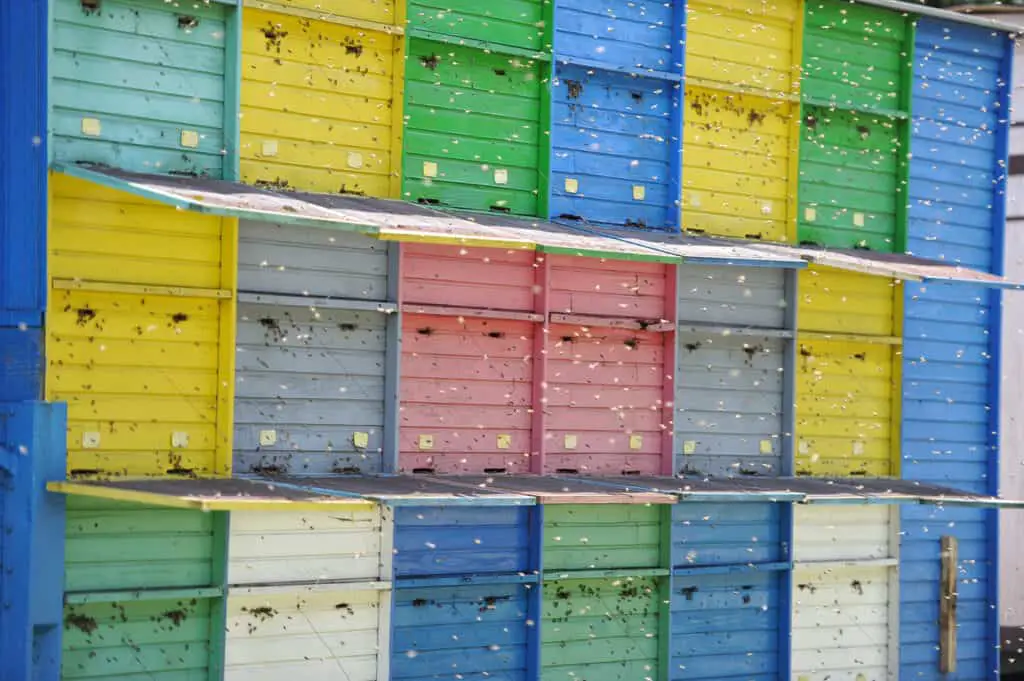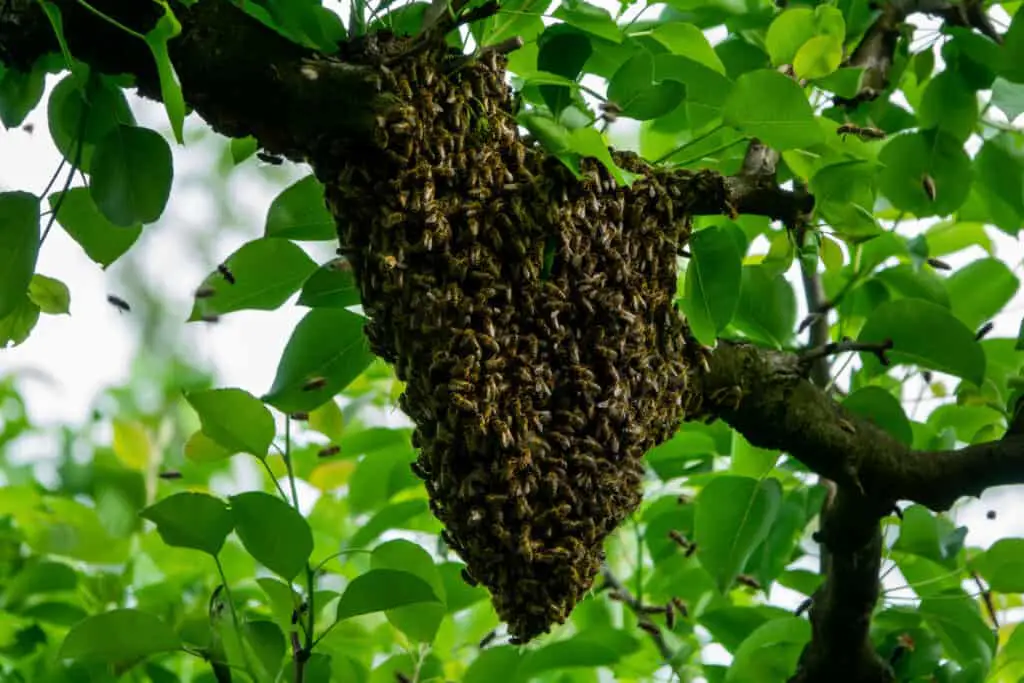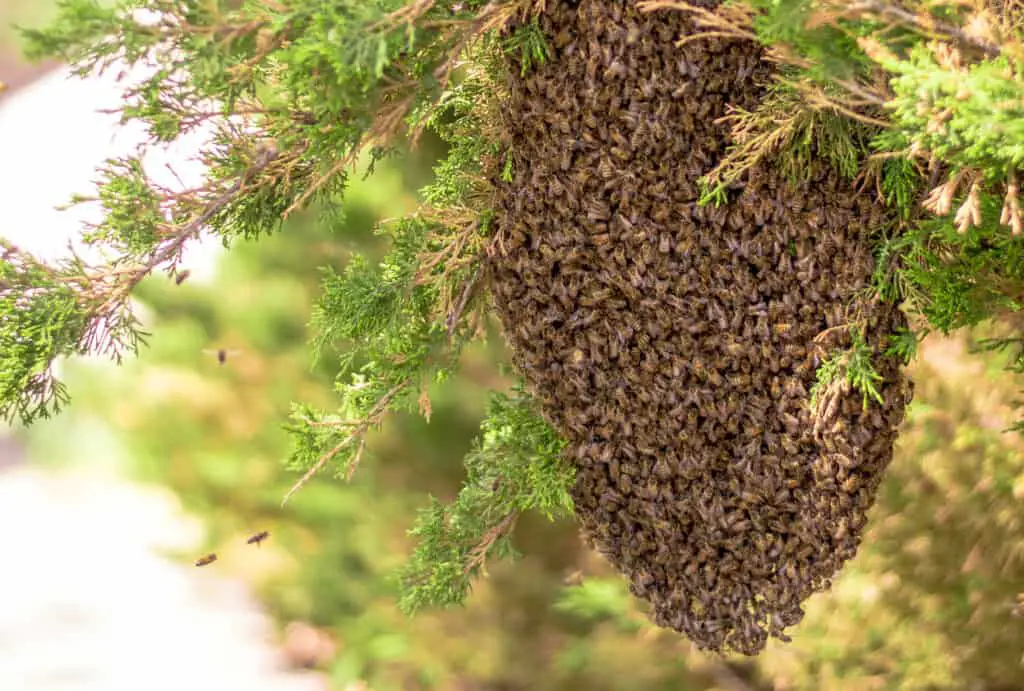Swarming is a natural process of bees increasing in numbers. It is a healthy event, and although it is dramatic, it can be fun to observe. However, you may not be a fan of a bunch of bees taking residence in your area. So, just how long do bee swarms stay in one location?
Bee swarms usually stay as long as it takes for bee scouts to find a suitable home. Bee swarms generally stay for several hours to a day. There have been instances where bee swarms stayed for as long as 3 to 4 days and even a couple of weeks if the conditions were favorable and the colony was happy.

When bees swarm, it can be scary, especially if you are allergic to them. However, fear not, as bee swarms generally do not stay in one area for long, and they typically aren’t a threat during that time unless they feel threatened.
How Long Do Bee Swarms Stay?

The length of time bee swarms stay depends on several factors, such as weather or food sources. Bee swarms are known to stay for a few hours to a day. However, there have been some instances where bee swarms have been seen to stay for 3 to 4 days and even a few weeks.
A swarm will only stay together until scout bees identify the most suitable new home. Wondering how long it takes bee scouts to find a new suitable home? It usually only takes scout bees a few hours to find a new place. It makes no difference whether there are any man-made hives in the vicinity. The bees are adept at locating hollows in trees and openings in houses and other structures.
If you’re wondering whether or not there are any bees left in the hive once they swarm, the answer is that only the old queen and around half the bees relocate to a new location. This will happen several days before the new queen is born because there can usually only be one queen in a hive. They will typically battle to the death when they come across another queen.
There are still queen cells in the old hive. The first queen to emerge has two options: she can kill the other queens while they are in their cells or leave with another swarm. To maintain her position as the only queen in the hive, the new queen will typically search for the other unborn queens and typically sting the unborn queens through their wax cells.
The initial colony’s power plays a significant factor in this. In the end, there is just one virgin queen left. She will embark on her mating flight and engage with approximately ten males after a week or two of being born. Then she goes back to the hive. After a few days, she will start laying eggs, and the cycle continues. The queen will begin to lay up to 2000 eggs daily for the next three years.
Is There A Reason Bees Swarm?

As with most events, there are several reasons bee swarms happen. Bees often swarm when there is a sense of crowdedness. Suppose in the spring, the hive is expanding swiftly and becoming crowded, and there aren’t many flowers blooming yet, or the weather has changed. In that case, the queen will place a fertilized egg in each of the several huge queen cups the female worker bees create, often 3 to 6.
As the larva develops, the worker bees will only feed it royal jelly, a substance they make, which will cause the larva to change from a female worker bee to a queen bee. This way, the queen can take half the colony with her so that there is more space created.
Another typical reason why swarming occurs is colony propagation. Due to the abundance of nectar and pollen, the parent colony is situated in a location where more bees can survive. The bees’ natural method of reproduction is swarming. One individual at a time is reproduced with humans. On the other hand, bees reproduce more on a larger scale and establish a brand-new colony.
This is normal and healthy. Bees also tend to swarm because of a failing queen. Therefore, some of the colony swarms out to make room for the brood cells required for the development of eggs into adult bees. Bees also swarm when the colony has outgrown its hive. The colony may also no longer be happy with its hive location.
Bees can decide to abscond when the hive becomes infected. The entire colony of flying bees and the queen look for another place to live that is free of the illness that infected their previous hive. One such infestation that occurs is varroa. The colonies survive varroa infestations by swarming and causing a break in the brood cycle as the varroa depends on it for reproduction.
When a hive is overflowing with honey, and the queen does not have enough space to lay the 2,000 eggs daily needed to replenish the hive’s daily losses, the bees may feel the need to swarm. One other reason that bees swarm is to replace an aging queen.
Why Do Bees Seem To Swarm Mostly In Spring?
Spring is when there is the greatest supply of bee food. This is because flowers are usually in full bloom during that time. Flowers in full bloom mean lots of pollen and nectar. This is healthy nourishment for bees, particularly in temperate climates. Colonies of honey bees are super-organisms. The colony symbolizes the body, and the bees are more like cells.
Queen bees mate on their own with drones, which are the males, from different colonies. The queen and around half of the worker bees eagerly leave the colony when food sources, which are the flowers, are plentiful and choose a tree branch or other object to cluster on.
In contrast, scout bees look for another ideal nesting site, usually a tree hole. Bees also prefer warmer climates, and spring and early summer provide that for them. Therefore, it is no wonder that you will see more bee swarms during that time and way less in winter.
How To Get Rid Of A Bee Swarm?
Swarms can seem threatening, yet they are actually at their most passive. They are extremely unlikely to sting during this time. However, they will sting if they detect a threat to their colony. Avoid exploring near a hive or a colony of swarming bees, or get ready for a defensive reaction.
Even though they aren’t dangerous during that time, you might still not like the idea of having so many bees around your area. To remove them properly, enlist a beekeeper, not an exterminator. Bees are pollinators and, therefore, are incredible insects as they benefit us in many ways. We would have significant difficulties in farming, gardening, and a wide range of other activities without bees.
How Far Do Bee Swarms Travel Once They Leave?
In a nutshell, the way it works is that the majority of the swarm gathers nearby the old nest and simply sits there. One percent of the bees scatter in all directions to look for and assess suitable sites for a new colony.
These scout bees then return and inform the other bees in the swarm of their discovery. Other bees may opt to scout that spot depending on the excitement of the announcement and the information communicated. They may also be persuaded to return to the swarm and promote it after seeing it for themselves.
If the location is suitable, hundreds of bees will eventually try to convince the remainder of the swarm to relocate. The entire swarm simply takes off and flies there once there is a loud enough demand for a particular place.
The bees will travel a mile or less toward their new home if there are several suitable locations within a one-mile range of the swarm. In this case, no scout is inclined to look farther than a mile away. Therefore, the only prospective places for a new home the other bees are aware of are those the scouts discover and return to mention.
Given that their goal was to escape an overcrowded colony rather than necessarily depart the area, they may end up staying just one tree from where they left. A flying bee expends energy 20 times faster than a runner because it must fly more forcefully into the wind. Therefore, it is uncommon for bees to travel more than 3 miles.
In contrast, no scout bee would fly more than 3 miles and survive to come back and live to tell the tale, regardless of if good nest sites are challenging to find. It’s improbable that enough bees will promote that place to persuade the entire swarm to choose it if scouts pass out from weariness on the return trip.
Can You Make Bee Swarms Stay Longer?
On rare occasions, a swarm can decide to build a comb where they end up landing in an effort to establish a hive. However, this is not always the case. If you are a bee lover and have no desire to see half of the bees split off from the rest, here are some ways to prevent that from happening.
Install Empty Frames In The Brood And Honey Areas
You can carefully place the bees in a box with the help of a beekeeper. The brood storage area and the honey storage sections of the beehive should get empty frames. The bees will be convinced that there’s work to be done in the hive and will be less likely to swarm.
When bees are overcrowded in the hive, and there’s a lot of honey stored, they swarm. Checker-boarding is the act of replacing full frames with empty ones. This will keep the bees from swarming. Ensure that you provide enough space for the bees, so they don’t feel like it is overcrowded.
It is better to checkerboard with frames that have already had comb drawn on them during the honey flow season. It prevents the bees from using resources to draw comb and keeps them busy making honey that you may harvest.
Split The Colony Before They Swarm
Split the colony of bees into two or more and keep them in separate beehives if you notice that the bees are particularly eager to swarm. The colonies won’t swarm since they’ll be too busy gathering nutrients in their new hives. You can reassemble the colonies into one or more strong hives if they become weak in winter.
Relocate The Queen Cells
In a beehive, when you are sure a queen bee is present and laying eggs, if you observe supersedure cells, the colony may be getting ready to swarm. Deny the bees a new queen bee by removing the supersedure cells. This is usually considered an unsavory way of keeping bees from swarming. However, it does the trick when you do not want to see any bees leave.
How To Tell When Bees Are Ready To Swarm
There are several ways you can tell when bees are prepping to swarm. A huge indication is when there is an overabundance of drone cells. Take note of drone cells as they are an early indication of bees preparing to swarm.
Bees generally increase the drone population before swarm cells are created. Once the bees start making queen cells, the chances that the bees are about to swarm are spectacularly high, and the bees will depart at any moment.
Conclusion
Bee swarms are a natural way that bees reproduce. They hardly stay in one area for long and tend to send out bee scouts to look for new suitable places. Therefore, you never have to worry about a swarm becoming too much of a problem for you. If it does become a problem, a beekeeper is always the best way to take care of the swarm.
References
http://ipm.ucanr.edu/PMG/PESTNOTES/pn74159.html

